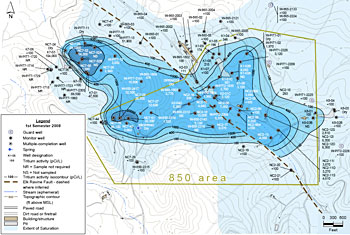
Landfill Characterization and Remediation at LLNL Site 300
Central Coast Ranges, California
Weiss Associates is supporting the Lawrence Livermore National Laboratory (LLNL) Environmental Restoration Department with subsurface characterization and remediation of landfills at the Pit 7 Complex at Site 300, a high explosives test facility and CERCLA Superfund Site. The Pit 7 Complex, located in the northwest corner of Site 300 about 17 miles east-southeast of Livermore, California, consists of four landfills (pits). From 1958 until 1988, the unlined pits received debris from high explosives experiments.
Weiss Associates' geologists, hydrogeologists and field technicians have played a major role in characterizing the hydrogeologic conditions and contaminant distribution at the Pit 7 Complex. Contaminants are released to ground water during periods of greater than average rainfall, such as El Nino winters, when the water table rises above the bottom of the pits and mobilizes contaminants from the landfill contents. Tritium released in this way from the Pit 7 Complex has commingled with tritium from other sources in the area. Other contaminants released from the pits include perchlorate, nitrate, uranium, and volatile organic compounds (VOCs).
Weiss Associates' staff played integral roles in preparing the Pit 7 Remedial Investigation/Feasibility Study and Interim Remedial Design reports. Monitored natural attenuation is the selected remedy for tritium at the Pit 7 Complex. To prevent any future releases from the pits, a drainage diversion system was installed that is designed to lower the water table beneath the pits. A treatment facility to remove perchlorate, uranium, and VOCs from extracted ground water was constructed in 2008, and ground water extraction and treatment began in 2009.
Weiss Associates' geologists and hydrogeologists will continue to have an active role in interpreting the performance monitoring data to evaluate drainage diversion system effectiveness and optimize ground water extraction and cleanup.
See Related Service >>
|

